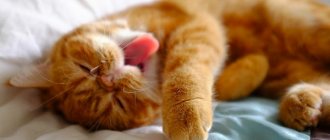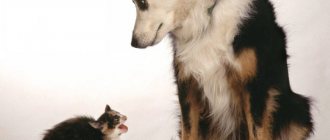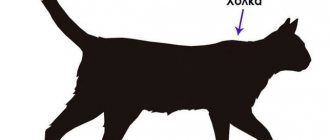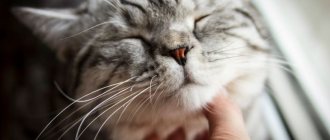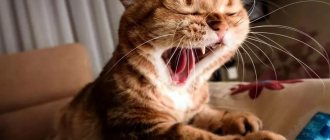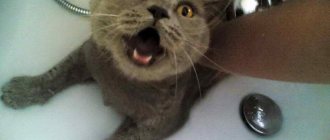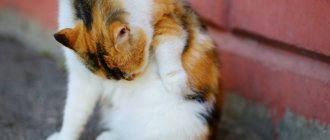Everyone knows perfectly well that if a dog wags its tail, it means it is experiencing positive emotions: it is happy, it wants to play. But not only dogs can do this. Cats also wag their tails very often, thereby showing their emotions. Only particularly attentive owners attach importance to this. But it is this small gesture that can say a lot about the mood of your furry friend. Let's look at the meaning of this action in more detail.
cat tail
What is a tail?
Once upon a time, all mammals had tails. But in the process of evolution, those of them who no longer needed this part of the body got rid of it. But cats need it for many reasons, so even today these animals can boast of long, flexible and strong tails.
The tail in cats is an extension of the spine
At its core, a cat's tail is an extension of the spine. It is attached to its main “dorsal” part with the help of a large vertebra. Each one following it decreases in size. Therefore, the tail of most cats resembles a whip, wide at the base and tapering towards the tip.
The vertebrae are fixed quite loosely, cavities form between them. They are filled with a special liquid, which also acts as a kind of lubricant. This allows the tail to move, wag and flex freely.
Cat skeleton
The length of the tail varies depending on the breed, body size and gender. On average, in cats it reaches 28 cm, in cats - 25. The owner of the longest is even listed in the Guinness Book of Records. The length of his pride piece is 44.66 cm.
This is the cat Cygnus. He has the longest tail in the world
essay my four-legged friend cat
I have many four-legged friends. One of them lives at my house. This is a fluffy and cute cat, whose name is Vasilisa. Vasilisa appeared in our house quite by accident. One summer, my family and I were vacationing in a village in Belarus and we learned that the neighbor’s cat had recently given birth to a kitten. When we saw the kitten, we really liked it - it was small, fluffy and striped, and its chest and legs were white. Almost the whole family spent several days trying to persuade our neighbor to give us this kitten. And finally, the neighbor agreed. On the very first day, when we brought Vasilisa home, she busily sniffed everything, asked for food, after which she began to play with us carefree - in general, she immediately felt at home. When the time came to leave back to Moscow, we were very worried about how our little Vasilisa would cope with the journey - since we had to travel almost one thousand kilometers by car. But all our worries were in vain - the road flew by unnoticed.
When Vasilisa was little, she was very funny and playful. She climbed the curtains and furniture, sometimes did not let her sleep at night and also grabbed her legs that were sticking out from under the blanket, but no one scolded her for it anyway, because we love our cat very much.
Messages [1 to 25 of 41]
Source
Why do cats wag their tail?
Deprived of the ability to express their emotions and thoughts verbally, that is, through speech, many animals have developed their own sign language. Cats are no exception. By changing their body position, they can show their attitude towards others, warn about something, declare war or provide a friendly welcome.
By changing their body position, cats show their attitude towards others.
Interesting! A cat's tongue, like any other, can develop. Scientists have proven that some gestures appeared in their “vocabulary” during the process of domestication. For example, only domestic animals can “hug” their owner’s leg with their tail, expressing their affection. Their wild relatives will not understand such a gesture.
However, tail wagging does not always mean that animals are trying to say something. So, if the air temperature is too high, they can use it as a kind of fan. In this case, unhurried, as if lazy movements of the tail will only mean that the animal is hot.
During the hot season, cats use their tail as a kind of fan.
A cat can activate its fifth limb in preparation for a jump. She needs this for proper balancing. The tail in this case plays the role of a rudder.
Also, some movements can signal poor health. Careful observation of your pet’s behavior will help you identify this or that disease in time and prevent it from developing.
What can a cat's tail tell you?
When the cat is happy
Like a dog, a cat often wags its tail to show joy. Usually at such moments the pet raises it high, and the tip of the tail begins to tremble. This means that the animal is either already experiencing pleasure or is anticipating some pleasant event. This behavior can be noticed when cutting meat for a cat, or taking out his favorite toy.
A cat can also wag its tail when it meets its owner returning home, rejoicing that its loneliness is finally over. And sometimes a pet with a trembling tail tip wakes up its owner in the morning, thereby hinting that it is time to feed or pet it.
When a cat is petted, it wags its tail not only from pleasure. With light movements of the object of her pride, she checks to see if an enemy is lurking nearby. Such wagging is an instinct necessary for an animal in the street or in the wild. But if the waving becomes more intense, this is a reason to stop petting the animal. Most likely, he is tired of her, and the warning will be followed by aggression - the cat may bite or scratch a dull person.
How to determine your pet's mood by its tail
The communicative function is one of the main ones for the tail. By waving it, the animal can demonstrate a whole range of emotions, from hatred to all-consuming love. Everything matters: the direction of movements, their amplitude and speed.
What does the position of a cat's tail indicate?
A complete dictionary of the “tailed” language could look like this:
| Gesture | Image | Explanation |
| The tail is raised sharply and “quivers” slightly | “I love you”, “I’m very glad to see you” | |
| The tail is raised and sways slightly | "Let's play" | |
| The tail lies on the floor and twitches slightly | “Something interesting”, “I’m interested” | |
| The tail moves quickly and sharply horizontally | “I don’t like this at all, I’m angry” | |
| Only the tip of the tail moves | “I am completely happy, calm and satisfied with life” | |
| The tail moves relaxed and calmly along a large trajectory | “I’m all lost in thought,” “What should I do now?” | |
| The tail moves quickly horizontally | “I’m extremely unhappy”, “You’re annoying me”, “Leave me alone” | |
| The tail beats the floor desperately | “I’m shocked”, “I’m stressed” | |
| Tail movements become faster | “Don’t come close to me”, “Now I’ll attack you” | |
| The tail is lowered and hangs loosely | “I’m happy with everything, but I’m determined to communicate” | |
| The tail is fluffed, raised up, motionless or slightly quivering | “I’m very angry”, “Everyone run away from me”, “Careful! Now I will kill" | |
| Tail up | “I’m in charge here and I feel good” | |
| The tail is raised and arched | “I sense danger and am ready to defend myself” | |
| Tail tucked | "I feel very bad" |
Interesting! Cats can also move their tail in their sleep. There is no need to be afraid of this. This only means that the pet is currently having a dream and is acting in accordance with its plot.
Interesting fact about the relationship between cats and people
What other reasons are there?
The owner is obliged to carefully monitor the pet in order to determine its mood and promptly identify developing pathologies. Cats are stingy in showing emotions; it is not always possible to determine that a pet is sick by appearance. The only accurate way to understand that an animal needs help is to observe the movements of the caudal spine.
The tip of the tail twitches
The pet wags its tip - either it is in a playful mood, or it is concerned about the lack of attention to its own person. Usually, a cat who wants to play, having noticed a curious object, examines it with interest and at the same time twists the tip. The trembling tip of a pet intensely staring out the window means that you have an unbearable desire, but it is impossible, to attack the birds in the yard.
Tail and back twitching
When a cat is healthy, its back twitches closer to its tail when it is nervous, irritated, or dissatisfied. The pet needs privacy and prepares to respond to squeezing with aggression.
An animal may jerk its back due to certain diseases:
- rabies - intense back spasms;
- parasitic infection - marked by twitching skin on the back half of the body;
- neurosis is a common reason why a cat’s tail twitches chaotically;
- vertebral injury – the pet presses the tail vertebrae;
- cancer - the cat begins to wave chaotically and constantly.
The tail is shaking
A slight trembling is a sign that the kitten has discovered an interesting object and is showing curiosity.
Quickly, with a low amplitude, the raised caudal process begins to tremble during the period of sexual heat: the pet becomes acquainted with an individual of the opposite sex. Similarly, a cat twitches its tail, expecting its owner to give it its favorite treat.
Tail held high
A vertically raised shoot held straight is a sign of friendliness. Cats usually perform an action that signifies joy and a desire to caress when they meet their beloved owner on the threshold. Sometimes, using the described method, the cat begs for a treat, demands to be stroked, at the same time purrs, and rubs against its shin.
Fluffy fur from the base to the tip of the raised spine means that the cat is scared and trying to cope with fear. The pet rears up - scared, but tries to scare the enemy in response.
Such defensive behavior is shaped by evolution in mammals. Homo sapiens has no fur, so the body is covered with goosebumps.
The cat, in addition to the above changes, arched its back and rounded its eyelids, which means extreme anger. Perhaps he noticed the offender, an angry dog.
Tail down
The explanation for the drooping tail varies:
- fear, dissatisfaction, desire to remain in peace and quiet;
- alertness, mistrust, confusion (lowered and extended position);
- sharp fear (tail fur fluffed up, limbs tucked in);
- diseases of internal organs (simultaneous symptom – apathy);
- internal pain (the cat either cannot wag its tail or nervously waves it).
The pet must be taken to a veterinary clinic if suspicious symptoms appear, in addition to sagging of the spinal process.
How else can a cat “talk”?
The tail is not the only way a cat can show its attitude. Animals have quite a lot of visual aids: ears, paws, and the whole body. Quite often they convey information using sound signals.
Interesting! Tailless cat breeds are becoming increasingly popular. Now there are several dozen of them. Some are already recognized as felinologists, others are just winning their hearts. The owners of such pets claim that the absence of a fifth limb does not interfere with their mutual understanding.
Tailless cat breeds
The human-cat dictionary can be supplemented with the following sections.
Communication using the body
Cat conversations can involve the whole body. With the help of movements, the animal is able to convey all important information and clarify details “left unsaid” by the tail.
| Gesture | Image | Designation |
| Ears raised up and tense | “I’m interested”, “I’m listening to you” | |
| Mustache pointing forward | “I am completely happy, calm and content” | |
| Mustache points backwards | “There’s danger somewhere nearby, but I’m on my guard.” | |
| Head down | “I acknowledge your superiority”, “I’m bored” | |
| Fingering with paws | “I love you”, “I want to please you” | |
| Rubbing on feet | “You are only mine”, “Stroke me” | |
| Somersault, belly up pose | “I trust you completely”, “I love you” | |
| Trying to touch a person's face with a paw | “I need your attention”, “Stroke me” | |
| Half-bent stance | “I feel danger, but I want to avoid a fight”; “Let’s resolve everything peacefully or I can’t vouch for myself” | |
| Arched back | "I will fight" |
Communication using glances
Eyes also play a huge role in dialogue. By studying the cat's language of views, you can not only learn to understand your pet, but also respond to him in such a way that he understands.
Do you want to tell your pet that you love him? Then squint a little and look closely into his eyes, and then slowly blink a few times
- bulging eyes, unblinking gaze - “I am the strongest here, go away”, “Fear me”;
- squinting, blinking - “I like you”, “I feel calm and comfortable.”
Advice! If you want to convey to your pet that you love him and will never hurt him, squint a little and look carefully into his eyes. And then blink slowly a few times.
What does the position of a cat's ears indicate?
Communication using sounds
Scientists estimate that cats can make about 30 different sounds. Each has its own meaning. Sometimes it is difficult for a person to distinguish one from the other. The owner’s ear may not be able to detect the change in timbre and volume. But there is a rule that will help determine the mood of the pet giving the sign. The lower his “meow” sounds, the more negative emotions he experiences.
The basic sounds that cats make can be translated into human language as follows:
- the usual even meow - “I need attention”, “Show me how you love me”;
- loud insistent meowing - “Give me something to eat”, “Pour me some water”, “Open the door for me”;
- deep guttural growl - “I’m very angry”, “Everyone disperse!”;
- hissing - “I’m scared, but I will defend myself to the last”, “Now I’ll give you a beating”;
- purring - “I feel very good”, “Keep doing what you are doing”;
- squeal - “It hurts!”
How to determine a cat's mood
Interesting! Some scientists suggest that cats make sounds only for humans, and their communication with their relatives can take place in complete silence. However, there are also opponents to this theory. Their main arguments are the voices that newborn kittens make and the “concerts” that adults throw only for “their own.”



